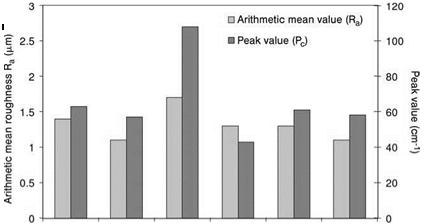It is difficult to bond glass durably unless special adhesion promoters are used (see Chapter and Section 5.10). When silane adhesion promoters are applied separately or

 |
Figure 7.58 Initial and the residual tensile shear strengths of different topographies.
|
Table 7.6 Failure patterns of mild steel bondings with different surface textures.
AF = adhesive failure (see Section 7.2.6); BC = bond-line corrosion; SCF = particular cohesive failure near the adhesive/substrate interface (see Section 7.2.6); OW 1 y = outdoor weathering for one year; P1200-30 = aging in accordance with VW standard 1200, 30 test cycles; P1200-60 = aging in accordance with VW standard 1200, 60 test cycles; SST = salt spray test for 1000 h; SBT, EDT, ECT, LDT, EBT-S, EBT-D = different textures (see Figure 7.56). |
admixed to the adhesive, glass can be bonded perfectly, and with a good durability. The results obtained with float glass bonded with a two-part epoxy resin adhesive and an adhesion promoter are shown in Figure 7.60 [23].
Following exposure of the joints to outdoor weathering for five years the joints were found to be covered over with algae, especially in those areas where the adhesive had leaked. On visual inspection of the bonding, using a stereomicroscope, no damage such as cracks, discoloring or delaminating was detected. In fact, only a strip of adhesive that had leaked from the bond-line had delaminated, and its surface had become cracky. However, when a destructive testing was performed the glass broke in the lap area. The residual strength was 16.4 ± 3.7 N mm~2 — that is, approximately 70% of the initial strength determined before aging. These results are only obtained when the adhesive, which in principle can be cured at room temperature, is cured at 120 °C for 1h, resulting in a better crosslinking and thus in an increase in the Tg-value.
![]()
 |
|
|
|
|

With regards to floatglass, durable bonds can also be achieved with silicone adhesives (see Section 8.3) or polysulfides containing silane. Silane-crosslinking polyurethane as well as epoxy resins, can also be considered, although problems are sometimes encountered with imperfect crosslinking in larger bonding areas. Finally, it is possible to use acrylate PSAs. While silane primers considerably improve the durability, a general cleaning with water and thorough drying at 40 °C is an adequate surface preparation for glass.
7.7.9
 31 октября, 2015
31 октября, 2015  Pokraskin
Pokraskin 
 Опубликовано в рубрике
Опубликовано в рубрике 